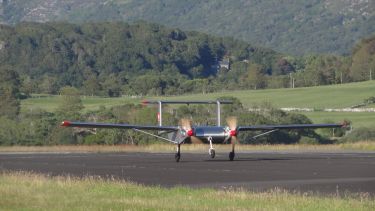- University of Sheffield researchers are developing advanced swarms of unmanned aircraft to gather crucial environmental data from Antarctica
- Swarms of aircraft will be tested by the British Antarctic Survey to help monitor wildlife, ice accumulation and weather conditions
- Technology will also be used by Fire and Rescue services in the UK to detect wildfires more quickly
- Swarms will be made up of ULTRA UAV’s – the largest commercial UAVs in the UK
Swarms of advanced unmanned aircraft are set to carry out aerial surveys of Antarctica – gathering crucial data on changes to the region’s environment and wildlife – as part of new research with engineers from the University of Sheffield.
The exciting new project, involving researchers from the University’s Department of Automatic Control and Systems Engineering, will advance swarm aircraft technology to conduct survey missions and mapping of large areas in Antarctica, quickly and with less human resource.
The British Antarctic Survey will test the new technology - using the unmanned aircraft to gather environmental data, such as monitoring wildlife, ice accumulation and weather conditions.
Aside from Antarctica, the aircraft will also be tested in the UK to help detect wildfires. This will build on previous research with the Lancashire Fire & Rescue Service that used unmanned aircraft to detect wildfires as early as possible to limit their devastating impact.
The swarm will be made up of ULTRA UAVs – the largest commercial UAVs in the UK.
The new research will advance the technology onboard the aircraft, to control their sequencing during the flights and to develop the unmanned aircraft’s ability to detect and navigate around obstacles and to dynamically change their flight path.
Lyudmila Mihaylova, Professor of Signal Processing and Control at the University of Sheffield, said about the project: “This is very exciting research that will develop the use of unmanned aircraft vehicles in swarms and to be used in innovative ways to protect our environment.
“In this project, the consortium partners aim to perform several live demonstrations of swarming unmanned aerial vehicles for survey missions in Antarctica and fire detection in the UK.
“Our expertise at the University of Sheffield will be to develop the algorithms to programme the aircraft to move together and to follow the planned flight path to complete the surveys. We will develop computer vision algorithms that will enhance the vehicles’ autonomy, especially during landing, and automatic recognition software for use in unmanned aerial vehicles.
“We have some of the world’s leading experts in control and systems engineering at the University of Sheffield, so this is a great opportunity to work with innovating companies as well as organisations that protect our precious environment.”
The project is being led by Windracers Limited together with the University of Sheffield, University of Bristol, Helix Technologies and Distributed Avionics.
Contact
For further information please contact:





